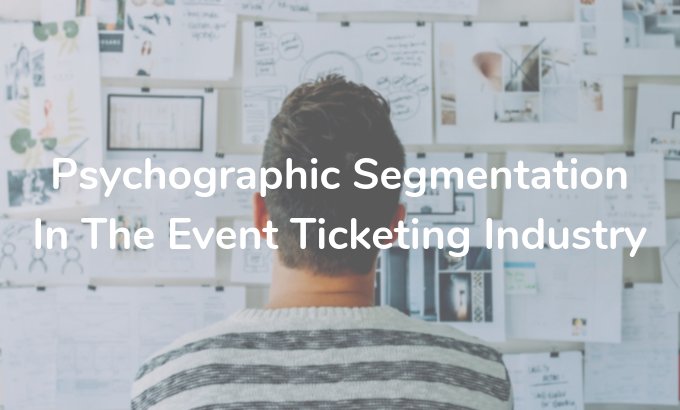
Competition is fierce within the event industry. The number of entertainment possibilities is endless: ranging from football games, museum exhibitions and theatre plays to meetups, social media and Netflix. All this puts a lot of pressure on marketing and sales. In fact, less than one-quarter of businesses are happy with their conversion rate.
A key factor in keeping conversion rates high, and an area many businesses lack an understanding of, is the personalities and attributes of event attendees. Yes, it is true that a good marketer usually knows the superficial demographic data of their audience and has a rough idea of who they are, but few people are able to truly understand their attendees on a deeper, personal level. This makes it hard to communicate, connect and build relationships with event participants. In order to solve this issue, successful event organisers are increasingly turning to psychographic segmentation.
Psychographic segmentation is an effective marketing method that focuses on identifying distinct customer segments based on their personalities, lifestyle and social status and then targeting them with tailor-made communication strategies. Compared to other customer segmentation models, such as demographics, behaviour or geographic segmentation, the psychographic categorisation model is aimed at the deepest and most important personal identity level: values, beliefs and purpose. This allows marketers to connect to the emotional level of their audience, which is what makes it so powerful. The main advantage of psychographic segmentation in ticketing is that it enables you to achieve a higher ROI, boost ticket sales and increase attendee loyalty through targeted marketing and communication, instead of running a single generic campaign for a more general audience.
Psychographic segmentation types
Depending on different models and approaches, there’s a variety of psychographic segmentation types available. However, the majority of approaches cover three principal categories: personality, lifestyle and social status:
Personality
To segment potential customers by personality traits, you’ll need to look at people’s values, beliefs and motivations. The main idea is to discover their overall outlook on life and what their purpose is in this world, in order to understand what leads their decision making and what drives them forward in life. The literature on personality-type classification is extensive and includes many popular models like the Myers-Briggs, the Big Five or the Four Color personality traits. When approaching this type of segmentation, analyze your particular audience and start to identify patterns yourself. Remember that your audience will most likely consist of multiple different personality groups.
Lifestyle
While personality segmentation deals with identifying fundamental (abstract) principles and driving forces of a person, lifestyle analysis is focused on their visible actions, decisions and preferences. When evaluating people’s lifestyle, marketers usually refer to the AIO (Activities, Interests and Opinions) model. Hence, in the first step, you’d be looking at people’s hobbies and activities: what jobs they have, what they do in their free time, how they spend their family time. Secondly, you’d want to learn about their interests: what TV shows they like, what their favourite sports team is and what books they read. Thirdly, you’ll want to know their opinions: what do they think about tax cuts for the wealthy, what is their stance on immigration laws, what political views do they have? Again, it is not about trying to put people into boxes but about spotting patterns and shared tendencies of your audience, that can then inform more personalized campaigns to boost your ticket sales.
Social status
Chances are high that your audience can also be divided based on different social status. Social status can be determined by a number of factors including their educational and cultural background, their current job or their level of income. Grouping your audience according to social status is more straightforward than other categories, but it still constitutes an important piece of information. In particular, understanding the buying power of a specific group can really help you boost the effectiveness of your campaigns. For instance, football clubs trying to sell high-spend VIP hospitality packages for a Champions League game might prefer to focus on white-collar workers, meanwhile targeting blue-collar workers for a third-division game.
How to use psychographic segmentation in event ticketing
In order to apply psychographic segmentation in the ticketing industry, you simply need to follow three steps:
- gather information
- segment your audience
- take action accordingly
1. Gather information

Event marketers have two different methods available when trying to obtain data for psychographic segmentation: primary research (collecting your own data) and secondary research (using pre-existing data). The latter might be a great place to start as they’re likely to uncover patterns quickly and without a high expenditure. However, if your business puts a strong emphasis on marketing, chances are that you can simply analyze your current CRM tools, your social media audience and ads, Google Analytics visitors insights and reuse other existing market research to generate your own customer data.
However, in most cases, your data will be incomplete and you will have to dig into primary research. This means that you might have to turn to online surveys, interviews and focus groups in order to get a bigger picture and a deeper understanding of your audience. In any case, you will have to be careful and thoughtful about the questions and information you ask for since these can involve private information and personal details. Moreover, given the recent GDPR regulation, we strongly recommend making sure you get consent, are transparent and only ask for data that you really need.
2. Segment your audience
After you’ve done the hard work and obtained sufficient information about your event attendees, it is time to analyze your data. Search for patterns and common characteristics amongst your attendees and use this to start creating personality groups. During this process, it is also important to take notice of anomalies instead of ignoring them, as they might uncover a new segment as well. In general though, psychographic segmentation works in the same way as demographic segmentation, only that you group people into categories based on personal traits, AIO & social status (as explained above) rather than on nationality, language and age.
3. Take action

Ultimately, the goal of psychographic segmentation is to take actions based on data. Whether you want to improve the event experience, sell more tickets or promote loyalty, the end result of segmentation should always give you practical insights that help you make better decisions. Psychographic segmentation is all about discovering the right audience for particular events and the campaigns you build around them. It enables you to learn more about audiences’ personality traits to gradually tweak and improve your events to create more value for audiences, which results in higher ticket sales for you too. The bottom line is to find a strategy that will make your attendees feel as if your event was created just for them, to show them that you speak the same language and that your beliefs match. This allows you to build stronger relationships and connect on an emotional level with your audience, boosting sales, loyalty and event attendee satisfaction.
Conclusion
Psychographic segmentation is an incredibly effective marketing method if you’re looking to make your marketing and sales strategies more successful, increase attendance figures, promote loyalty and build stronger relationships with your audience. While the data collection stage might sound daunting at first, there are several digital tools that can facilitate this process for you. For instance, at Onebox we already help event organisers to gather demographic data of ticket buyers via our ticketing solution and we’re also currently working on developing a new tool that will facilitate the collection of psychographic data. In addition to that, our real-time analytics, reporting and CRM solutions help users gain critical insight and clarity into performance and customer’s behaviours, identify risks, opportunities and accelerate profitability.
Moreover, once you’ve created the psychographic groups of your audience, remember that it’s ultimately about taking action based on your key learnings. Onebox is on hand to help with that too: Our Client Success Team will be happy to advise you on selecting the right ticket sales channel based on your psychographic and demographic segmentation. Additionally, our ticket distribution system also allows you to follow up on the results of your psychographic segmentation by adjusting ticket prices through different promotions for each sales channels accordingly, all within one powerful platform.


